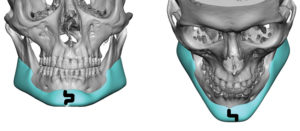A custom jawline implant is undoubtably the best method to augment the entire lower third of the face. Since it covers the entire jaw from angle to angle crossing the chin it creates both volume and definition for a more distinct transition of the face into the neck. Its one-piece design also offers a lower risk of malposition than of three separate implants (chin and two jaw angles) were used to create a total jawline effect.
But despite the many advantages of a one-piece implant design, these advantages are have one disadvantage and it is an important one…surgical placement. Since a three incisional approach is used (two posterior vestibular incisions and one anterior intraoral/submental incision), how is such a one-piece implant inserted when it is far bigger than any one of these incisions alone? The answer to this questions lies in the more narrow tunnel that connects the larger chin and jaw angle pockets the are dissected out.
The key to placement is the size of the chin and the jaw angle components, the end points of the implant. If the jaw angles are not overly ‘big’ the implant can be inserted in a front to back approach as an intact unit. The jaw angle portions are folded and inserted through the anterior incision where they can safely pass through the smaller tunnel that connects the chin and jaw angle pockets with a low risk of injury to the mental nerve.


This split implant technique is what allows even very large custom jawline implants to be successfully inserted. The flexibility of the silicone material is also a very important aspect in the insertion of any large silicone facial implant.
Dr. Barry Eppley
Indianapolis, Indiana


